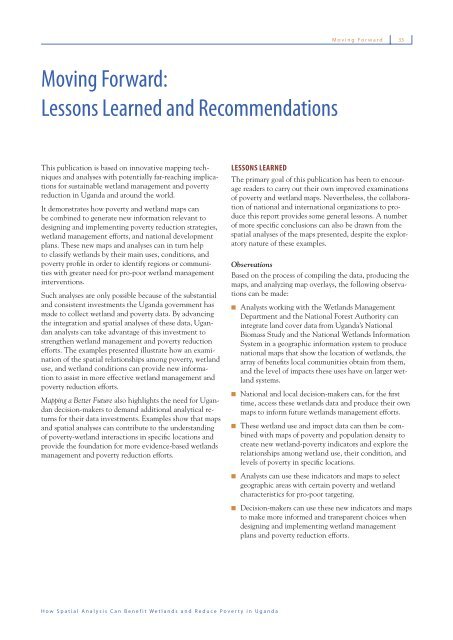Mapping a Better Future - World Resources Institute
Mapping a Better Future - World Resources Institute
Mapping a Better Future - World Resources Institute
You also want an ePaper? Increase the reach of your titles
YUMPU automatically turns print PDFs into web optimized ePapers that Google loves.
Moving Forward<br />
33<br />
Moving Forward:<br />
Lessons Learned and Recommendations<br />
This publication is based on innovative mapping techniques<br />
and analyses with potentially far-reaching implications<br />
for sustainable wetland management and poverty<br />
reduction in Uganda and around the world.<br />
It demonstrates how poverty and wetland maps can<br />
be combined to generate new information relevant to<br />
designing and implementing poverty reduction strategies,<br />
wetland management efforts, and national development<br />
plans. These new maps and analyses can in turn help<br />
to classify wetlands by their main uses, conditions, and<br />
poverty profi le in order to identify regions or communities<br />
with greater need for pro-poor wetland management<br />
interventions.<br />
Such analyses are only possible because of the substantial<br />
and consistent investments the Uganda government has<br />
made to collect wetland and poverty data. By advancing<br />
the integration and spatial analyses of these data, Ugandan<br />
analysts can take advantage of this investment to<br />
strengthen wetland management and poverty reduction<br />
efforts. The examples presented illustrate how an examination<br />
of the spatial relationships among poverty, wetland<br />
use, and wetland conditions can provide new information<br />
to assist in more effective wetland management and<br />
poverty reduction efforts.<br />
<strong>Mapping</strong> a <strong>Better</strong> <strong>Future</strong> also highlights the need for Ugandan<br />
decision-makers to demand additional analytical returns<br />
for their data investments. Examples show that maps<br />
and spatial analyses can contribute to the understanding<br />
of poverty-wetland interactions in specifi c locations and<br />
provide the foundation for more evidence-based wetlands<br />
management and poverty reduction efforts.<br />
LESSONS LEARNED<br />
The primary goal of this publication has been to encourage<br />
readers to carry out their own improved examinations<br />
of poverty and wetland maps. Nevertheless, the collaboration<br />
of national and international organizations to produce<br />
this report provides some general lessons. A number<br />
of more specifi c conclusions can also be drawn from the<br />
spatial analyses of the maps presented, despite the exploratory<br />
nature of these examples.<br />
Observations<br />
Based on the process of compiling the data, producing the<br />
maps, and analyzing map overlays, the following observations<br />
can be made:<br />
Analysts working with the Wetlands Management<br />
Department and the National Forest Authority can<br />
integrate land cover data from Uganda’s National<br />
Biomass Study and the National Wetlands Information<br />
System in a geographic information system to produce<br />
national maps that show the location of wetlands, the<br />
array of benefi ts local communities obtain from them,<br />
and the level of impacts these uses have on larger wetland<br />
systems.<br />
National and local decision-makers can, for the fi rst<br />
time, access these wetlands data and produce their own<br />
maps to inform future wetlands management efforts.<br />
These wetland use and impact data can then be combined<br />
with maps of poverty and population density to<br />
create new wetland-poverty indicators and explore the<br />
relationships among wetland use, their condition, and<br />
levels of poverty in specifi c locations.<br />
Analysts can use these indicators and maps to select<br />
geographic areas with certain poverty and wetland<br />
characteristics for pro-poor targeting.<br />
Decision-makers can use these new indicators and maps<br />
to make more informed and transparent choices when<br />
designing and implementing wetland management<br />
plans and poverty reduction efforts.<br />
How Spatial Analysis Can Benefit Wetlands and Reduce Poverty in Uganda

















